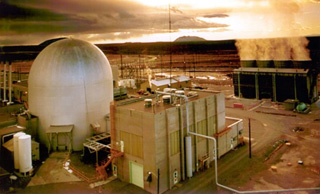From Fukushima's home country: Nuclear will double
 Japanese industrial conglomerate Hitachi Ltd., has boldly predicted that it will more than double sales of nuclear power plants by 2020.
Japanese industrial conglomerate Hitachi Ltd., has boldly predicted that it will more than double sales of nuclear power plants by 2020.The company is targeting $4.5 billion (360 billion yen) in sales by fiscal year 2020, up from $1.5 billion (120 billion yen) in 2011, according to a management plan it released last week.
The growth projection is notable coming from a company in Japan, where the 2011 meltdowns at the Fukushima Daiichi nuclear plant caused the evacuation of some 200,000 people and led to a temporary shutdown of all 54 nuclear stations. Reactors melted down after a devastating tsunami knocked out generators that powered Fukushima Daiichi’s cooling systems.
But Hitachi is not counting on domestic growth. In a presentation accompanying its management plan, it said it would “accelerate overseas development of the nuclear power systems business,” and that it is a positioning nuclear power “as an effective source of energy for curbing CO2 emissions to meet continuing global demand.”
MarketWatch reported that Hitachi will benefit from “cashing in on an expected rise in worldwide demand” for nuclear power (The article misstates the sales prediction as millions instead of billions).
Countries including China and India plan to expand nuclear’s contribution to their energy sources. China is even grabbing up the world’s uranium supply to help it secure a nuclear future.
Hitachi develops and sells nuclear reactors and services through its partnership with General Electric, called General Electric Hitachi Nuclear Energy (GEH). GEH is developing a safer form of its conventional boiling water reactor, and is also developing an alternative reactor known as a fast neutron reactor (FNR) which would burn plutonium waste from other reactors and thus represent a method for both generating power and eliminating a dangerous byproduct.
GEH calls its FNR “PRISM” and bases it on the Experimental Breeder Reactor II that the U.S. operated until 1994 in Idaho.
FNRs have been historically difficult to run safely. Bill Gates TerraPower is developing a type of FNR called a traveling wave reactor. San Diego’s General Atomics is also developing one called the Energy Multiplier Module.
A number of other alternative nuclear designs are emerging that could challenge conventional water-cooled, uranium fueled reactors. They include reactors that run on thorium instead of uranium (GEH has never answered my inquiries as to whether they’re researching thorium). Japanese utility Chubu Electric Power Co. recently announced it is investigating thorium as a safe nuclear alternative.
A handful of startup companies including Lawrenceville Plasma Physics have also reported advances in nuclear fusion, the elusive holy grail of energy generation.
In its management plan, Hitachi also said it is participating in the decommissioning of Fukushima, and that it is developing safety features for Japanese nuclear plants.
Meanwhile, Japanese Prime Minister Yoshihiko Noda last weekend ordered the restart of two nuclear reactors. Before the nationwide shutdowns, nuclear had provided 30 percent of the country’s electricity.
You can return to the main Market News page, or press the Back button on your browser.

